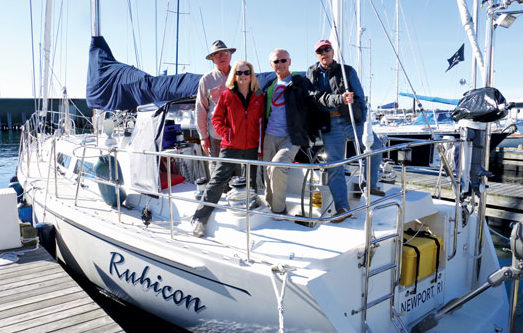
The prospect of blue water sailing can sound both wonderful and worrying to coastal cruisers considering taking the plunge offshore. This is one reason why rallies, which offer benefits such as pre-rally safety seminars and a brain trust of experienced sailors, have become popular. Indeed, it is longtime ralliers who are a great resource for those who are either on the fence or already fired up for their first rally.
Make your Lists Early and Have a Timeline!
“A first offshore passage is always a little intimidating, or at least it should be, but with proper planning, diligence in preparation and a good crew you’ll experience the magic of offshore passage-making,” says Peter Bourke, who joined the North American Rally to the Caribbean (NARC) to sail his Outbound 44, Rubicon, from his home in Newport, RI, to the islands for the first time. Bourke says one advantage of a rally for him is that it sets a date, subject to the weather of course, and once a departure date is set, the planning and preparation process could fall into a logical schedule. “For a newcomer, I’d advise making your lists early and having a timeline. There are plenty of good articles available online about taking an offshore passage on a sailboat.”

Buying new equipment, either to replace old or add to the vessel’s inventory, is often a key part of pre-rally preparation.
“Use all new equipment for at least a month or more in differing conditions to make sure you know how to use it and that it is functioning properly,” recommends Anne Poor, who with husband Miles lives aboard their Tayana 55, Karina. Miles was the first to rally, joining the Caribbean 1500 in 1998 as a crew member on another boat to get experience. He and Anne did their first rally aboard Karina in 2004 and have continued to sail with the now ARC Caribbean 1500 each year. “Warranty work is much easier when you are on the same continent as your installer.”

There are a few unique things that Phillip Worrall does before setting sail south aboard his Caliber 40, Rum Runner, in the Salty Dawg Fall Rally to the Caribbean. Although Worrall started doing shorter rallies like the Delmarva 400 and New England 600 in the late 1990s and early 2000s, and later moved onto the Caribbean 1500, he has enjoyed annually participating in the Salty Dawg since 2012.
“I stow my anchors below in the anchor locker and then shrink-wrap tape the bow locker and hatches to avoid water intrusion. I also zip-tie all shackles and clevises, carry spares for everything, always keep one reef in the mainsail and practice storm sail rigging,” he says.

During the trip, Worrall implements several things he’s discovered on successive rallies.
One of these is learning how to heave to and then do it when seas are rough, and everyone is tired. Worrall also says,
- If you see a squall ahead, aim right for it because it will be gone by the time you get there.
- Serve hot food every day.
- Do not let yourself or any of the crew get exhausted and
- stay close to or on the rhumb line for the entire trip.”
- Do carry as much fuel as possible because there may be windless days.
“Don’t tarry. The longer you are on the ocean, the more chance there is for weather and other issues to bite you. We like to keep moving toward the British Virgin Islands, says Karina’s Poor.
Stay focused, adds Rubicon’s Bourke. “Make a practice while underway of going forward for a daily inspection of everything you can lay your eyes on. After the passage, celebrate, then make a note of the particulars that you’ve learned about your boat that will help you on the next passage.”
Finally, “tie up to a dock for a few days to sort out the mayhem on the boat after ten days plus of sailing,” recommends Rum Runner’s Worrall. “Plan on spending at least a week after the trip to meet and socialize before taking off on your own.”





